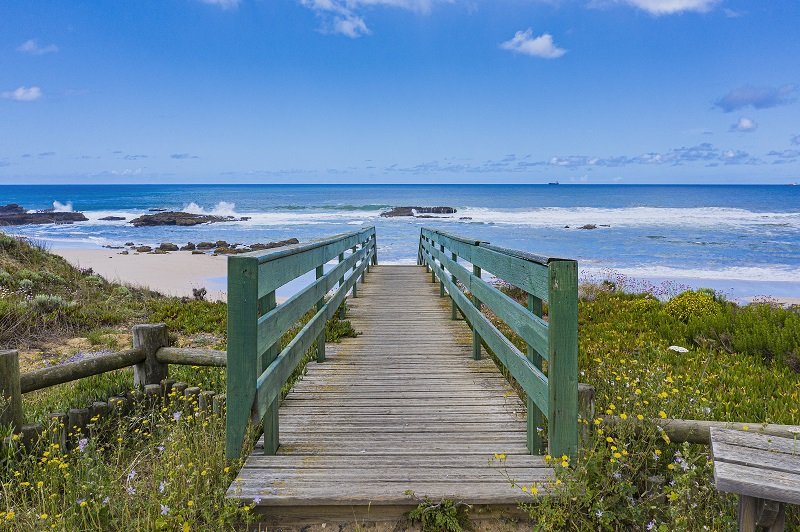I was heartbroken when I hiked the Rota Vicentina.
To be sure, the trip had been planned well before I broke up with my reason for moving to Portugal. But the timing turned out to be perfect, as the endlessly beautiful scenery, and warm welcomes in every town I passed through, were just what I needed to start mending my heart.
There have long been hiking and trails along the Alentejo coast, but in recent years, a number of communities banded together to promote the Rota Vicentina as a travel destination. Now the trails are well signposted, hotels and restaurants have sprung up, and volunteers keep everything well maintained.
There is no one Rota Vicentina. Rather, it is a network of more than 750 kilometers (466 miles) of hiking and mountain biking trails. That said, there are two main routes for hikers (like heartbroken me) who want to lose themselves in nature for days on end.
The Historical Way passes through the main towns of the region, such as Porto Covo, Odemira, and São Teotónio, and then out of the Alentejo and down into the Algarve. It is mostly rural trails through gorgeous cork tree forests, rivers and valleys, and, in spring, fields of yellow wildflowers. Spanning 263 kilometers (163 miles), it is divided into 13 sections of easy but beautiful terrain.
More challenging and more dramatic, the Fisherman’s Trail hugs the cliffs along the stunning Vicentina coast. It stretches 226.5 kilometers (141 miles), also divided into 13 sections. There are stretches where the sand is as soft as a beach, and there’s often wind in your face, but those views of the crashing waves are captivating. In spring, when I did it, the ground around the trail was covered with succulents with purple and yellow blossoms. (These are called pigface carpobrotus in their native Australia, and even though I know they’re an invasive species, they are undeniably beautiful.)
It was exactly the medicine I needed to get out of my head, take comfort in beauty and nature, and put my minor problems in perspective. It also helped me recommit to Portugal, at a time when many of my American friends were asking if I would move back to the States since it didn’t work out with the guy. This country is way too magnificent to leave.
Serious adventure travelers through-hike the route, sometimes camping along the way. But after nearly two decades of writing about luxury travel, I do not camp.
Thankfully, there are a variety of accommodations along the way, including some rather nice small hotels. Fittingly, my trip was organized by an outfit called We Love Small Hotels, which actually specializes in soft adventure travel—slack-packing—but, you know, with nice small hotels for showering and sleeping after each day on the trail.
For rests during the day, it was always easy to descend down to one of the near-empty beaches and watch the surfers at play. These beaches may not be the sexiest in Portugal: The water is cold, and the air is generally cooler than elsewhere, and there’s not much in the way of concessions. But because of that, they’re not at all crowded, at least not in the spring or autumn.
And even though the Costa Vicentina is one of the best-preserved coastal areas in Europe, there are still enough towns in the region that food is never all that far away. (This is Portugal: Good food is never very far away.) The fish and shellfish are outstanding, and I’m still dreaming about the octopus salad and seafood rice at Restaurante Azenha do Mar in the fishing village of the same name.
Although the Fisherman’s Way extends all the way to Cabo de São Vicente, the southwestern-most point in Europe, I ended my hike in Odeceixe, a coastal village that makes the boundary between the Alentejo and the Algarve. The view over Odeceixe beach from the Ponta em Branco is one of the most magnificent of the whole journey. Taking it in, pleasantly tired after a week on the hiking trail, I forgot all about my heartache.
Just one hour from Lisbon, and an easy flight from the US and Canada, the Alentejo is unique in all of Europe. The Portuguese often refer to the Alentejo, with its own dialect, Moorish flavors, white washed towns, and unique songs, as its own nation. Most towns seem to float on hilltops above the plains or a long Atlantic Coast, embraced by a castle. Gothic towers and red tiles rise from the venerable walls.
* Ann Abel has been an award-winning travel writer and editor for 18+ years — including several as a senior editor at ForbesLife – and she has written about more than 600 luxury destinations and hotels in 97 countries.



